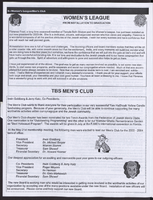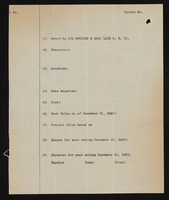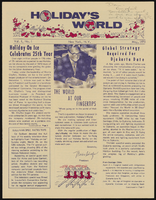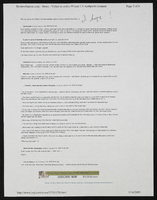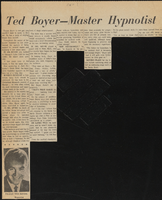Search the Special Collections and Archives Portal
Search Results
Barbara Davis oral history interviews
Identifier
Abstract
Oral history interviews with Barbara Davis conducted by Joanne Goodwin on December 18, 1996 and March 25, 1997 for the Women's Research Institute of Nevada (WRIN) Las Vegas Women Oral History Project. Davis opens her interviews by discussing her audition for the Folies Bergere as a dancer with limited experience. Davis describes working with the Folies Bergere as a touring showgirl in the 1940s. She discusses touring the United States in the Folies Bergere, touring South America for three years, and going to college at night while performing during the day. Davis then talks about the city of Reno, Nevada and working as a showgirl there. Davis addresses common rumors about showgirls, such as being involved in prostitution or being addicted to gambling. She then discusses her interest in education in her later years including earning various post graduate degrees. Davis ends her interview with a discussion on classic entertainment of the 1940s, including vaudeville and entertainment hotspots of the time.
Archival Collection

Transcript of interview with Chuck Degarmo by Stefani Evans, January 13, 2017
Date
Archival Collection
Description
Southern California native and lifetime resident, landscape architect Chuck Degarmo evokes the Golden State's iconic theme park as he reflects on forty years in the landscape industry and the ways his work has shaped the way Southern Nevada looks and works. It is fitting he would do so. Degarmo forged his professional ties to Las Vegas in 1993, during the heyday of the Las Vegas Strip's "family-friendly" era, when Kirk Kerkorian's MGM Grand Hotel and Casino hired Degarmo's firm, Coast Landscape Construction, to design and landscape their planned 33-acre MGM Grand Adventures Theme Park. In this interview, Degarmo outlines his work history, which draws upon the combined skills of a salesman, an artisan, a problem-solver, and an entrepreneur. Having owned his own firms and worked for industry giants Valley Crest Companies and BrightView Landscape Development, he discusses an array of topics from running union and non-union crews; Tony Marnell and design-build projects; importing plant material into Nevada; the Neon Museum and Boneyard; The Smith Center for the Performing Arts and Symphony Park; Steve Wynn, the mountain at Wynn Las Vegas, and Lifescapes International; the Lucky Dragon; Cosmopolitan, CityCenter, and the Vdara "death ray", and the Southern Nevada Public Lands Management Act (SNPLMA). Throughout, Degarmo articulates his work through the lens of a lifetime Southern Californian whose talent has contributed much to the Southern Nevada landscape.
Text
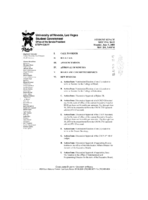
Meeting minutes for Consolidated Student Senate, University of Nevada, Las Vegas, June 26, 2000
Date
Archival Collection
Description
Text
Audio recording clip of interview with Dr. Porter Troutman by Claytee D. White, November 20, 2006
Date
Archival Collection
Description
Part of an interview with Dr. Porter Troutman by Claytee White on November 20, 2006. Troutman describes his career as an educator.
Sound

Transcript of interview with Jelindo Tiberti by Stefani Evans and Claytee D. White, April 18, 2017
Date
Archival Collection
Description
As Jelindo Tiberti describes his childhood as the youngest of five children growing up on 15th Street, he chronicles a seemingly idyllic time of playing with a large group of neighborhood friends, of doing outdoor chores with his brothers, of spending summers at the family cabin in Utah, of high school dances, and as a high school junior, of meeting Sandee, whom he would marry within two months after they both graduated from the University of Southern California. He talks about his parents: about working for and with his namesake father; about taking his mother to her daily radiation treatments, about cooking his mother's recipes, and about his mother making sure her youngest child earned his college degree before he married. He explains the ubiquity of fencing and shares his experience of taking over Tiberti Fence Company, of retiring and selling the company, and of starting over with Red Star Fence Company. Throughout, Tiberti speaks to living with dyslexia: of attending an after-s
Text

